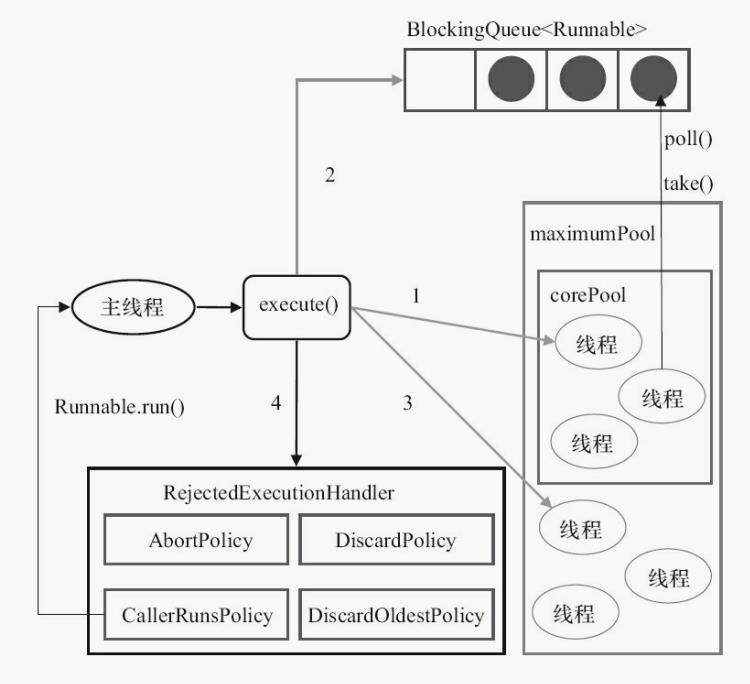线程池简洁版
Posted 后端小知识
tags:
篇首语:本文由小常识网(cha138.com)小编为大家整理,主要介绍了线程池简洁版相关的知识,希望对你有一定的参考价值。
一、线程池简洁版

每个人有自己的生活方式,每个人有自己对待感情的态度
1.1 概念
使用线程池的好处
-
降低资源消耗。通过重复利用已创建的线程降低线程创建和销毁造成的销耗。
-
提高响应速度。当任务到达时,任务可以不需要等待线程创建就能立即执行。
-
提高线程的可管理性。线程是稀缺资源,如果无限制的创建,不仅会销耗系统资源,还会降低系统的稳定性,使用线程池可以进行统一的分配,调优和监控。
1.2 线程池的主要处理流程
这几张图先看一下,打个照面,等会读完再回来看下,会有意想不到的收货额

hreadPoolExecutor执行示意图

1.3 线程池的使用
1.3.1 概述
首先,Java中的线程池是通过Executor框架实现的,该框架中用到了Executor,Executors,ExecutorService,ThreadPoolExecutor这几个类
1.3.2 三种创建方式
//执行长期任务性能好,创建一个线程池,一池有N个固定的线程,有固定线程数的线程
ExecutorService threadPool = Executors.newFixedThreadPool(5);
//一个任务一个任务的执行,一池一线程
ExecutorService threadPool = Executors.newSingleThreadExecutor();
//执行很多短期异步任务,线程池根据需要创建新线程,
//但在先前构建的线程可用时将重用它们。可扩容,遇强则强
ExecutorService threadPool = Executors.newCachedThreadPool();
小案例
private static void threadPoolDemo()
ExecutorService threadPool = Executors.newFixedThreadPool(5); //一池 5 个线程
// ExecutorService threadPool = Executors.newSingleThreadExecutor(); //
// ExecutorService threadPool = Executors.newCachedThreadPool();
// 池化技术使用后需要释放
try
// 模拟 10个顾客办理业务,目前池子有 5个工作线程提高服务
for (int i = 1; i <= 10; i++)
try TimeUnit.SECONDS.sleep(1); catch (InterruptedException e) e.printStackTrace();
threadPool.execute(() ->
System.out.println(Thread.currentThread().getName() + "\\t 办理业务");
);
// try TimeUnit.SECONDS.sleep(4); catch (InterruptedException e) e.printStackTrace();
catch (Exception e)
e.printStackTrace();
finally
threadPool.shutdown();
1.3.3 使用 ThreadPoolExecutor创建
先放代码,现在看不懂先看下面的
public static void main(String[] args)
// threadPoolDemo();
ExecutorService threadPool = new ThreadPoolExecutor(
2,
5,
2L,
TimeUnit.SECONDS,
new LinkedBlockingQueue<>(3),
Executors.defaultThreadFactory(),
new ThreadPoolExecutor.AbortPolicy()
);
try
for(int i=1;i<=8;i++)
// TimeUnit.SECONDS.sleep(1);
threadPool.execute(()->
System.out.println(Thread.currentThread().getName()+"\\t 办理业务");
);
catch (Exception e)
e.printStackTrace();
finally
threadPool.shutdown();
1.4 线程池的7种参数
我们查阅底层源码可知ThreadPoolExecutor的构造方法有七个参数,这个参数是按照ThreadPoolExecutor里面的参数顺序来写的
| 参数名 | 解释 |
|---|---|
| corePoolSize | 线程池中的常驻核心线程数 |
| maximumPoolSize | 线程池中能够容纳同时执行的最大线程数,此值必须大于等于1 |
| keepAliveTime | 多余的空闲线程的存活时间 当前池中线程数量超过corePoolSize时,当空闲时间 达到keepAliveTime时,多余线程会被销毁直到 只剩下corePoolSize个线程为止 |
| unit | keepAliveTime的单位 |
| workQueue | 任务队列,被提交但未被执行的任务 |
| threadFactory | 表示生成线程池中工作线程的线程工厂,用于创建线程,一般默认的即可 |
| handler | 拒绝策略,表示当队列满了,并且工作线程大于等于线程池的最大线程数(maximumPoolSize)时如何来拒绝请求执行的runnable的策略 |
1.5 用哪一个线程池
前面1.3中说了有三种创建方式,那么我们在实际开发中,用哪一个比较好呢?
答案是:都不用
我们只使用自定义的,原因是

图中说的方式正是我们上面1.3.3中代码
以上是关于线程池简洁版的主要内容,如果未能解决你的问题,请参考以下文章